Changes in the Structure of Amorphous Alloys under Deformation by High-Pressure Torsion and Multiple Rolling
Abstract
1. Introduction
2. Materials and Methods
3. Results and Discussion
4. Conclusions
Author Contributions
Funding
Institutional Review Board Statement
Informed Consent Statement
Data Availability Statement
Conflicts of Interest
References
- Perepezko, J.H. Nucleation-controlled reactions and metastable structures. Prog. Mater. Sci. 2004, 49, 263–284. [Google Scholar] [CrossRef]
- Yang, B.J.; Yao, J.H.; Chao, Y.S.; Wang, J.Q.; Ma, E. Developing aluminum-based bulk metallic glasses. Philos. Mag. 2010, 90, 3215–3231. [Google Scholar] [CrossRef]
- Abrosimova, G.E.; Aronin, A.S.; Pankratov, S.P.; Serebryakov, A.V. Specific features of amorphous Fe85B15 alloy crystallization prepared by melt quenching from different temperature. Scr. Metall. 1980, 14, 967–969. [Google Scholar] [CrossRef]
- Naka, M.; Masumoto, T.; Chen, H.S. Effect of metalloidal elements on strength and thermal stability of Fe-base glasses. J. De Phys. C 1980, 41, C8-939. [Google Scholar]
- Louzguine-Luzgin, D.V.; Jiang, J. On long-term stability of metallic glasses. Metals 2019, 9, 1076. [Google Scholar] [CrossRef]
- Boucharat, N.; Hebert, R.; Rösner, H.; Valiev, R.; Wilde, G. Nanocrystallization of amorphous Al88Y7Fe5 alloy induced by plastic deformation. Scr. Mater. 2005, 53, 823–828. [Google Scholar] [CrossRef]
- Han, J.H.; Mattern, N.; Vainio, U.; Shariq, A.; Sohn, S.W.; Kim, D.H.; Eckert, J. Phase separation in Zr56-xGdxCo28Al16 metallic glasses (0 < x < 20). Acta Mater. 2014, 66, 262–272. [Google Scholar] [CrossRef]
- Ojovan, M.I.; Tournier, R.F. On structural rearrangements near the glass transition temperature in amorphous silica. Materials 2021, 14, 5235. [Google Scholar] [CrossRef]
- Ojovan, M.I.; Louzguine-Luzgin, D.V. On Structural Rearrangements during the Vitrification of Molten Copper. Materials 2022, 15, 1313. [Google Scholar] [CrossRef]
- Louzguine-Luzgin, D.V. Structural Changes in Metallic Glass-Forming Liquids on Cooling and Subsequent Vitrification in Relationship with Their Properties. Materials 2022, 15, 7285. [Google Scholar] [CrossRef]
- Ohta, M.; Yoshizawa, Y. Magnetic properties of nanocrystalline Fe82.65Cu1.35SixB16−x alloys (x = 0–7). Appl. Phys. Lett. 2007, 91, 062517. [Google Scholar] [CrossRef]
- Makino, A.; Men, H.; Kubota, T.; Yubuta, K.; Inoue, A. New Fe-metalloids based nanocrystalline alloys with high Bs of 1.9T and excellent magnetic softness. J. Appl. Phys. 2009, 105, 07A308. [Google Scholar] [CrossRef]
- Abrosimova, G.; Matveev, D.; Pershina, E.; Aronin, A. Effect of treatment conditions on parameters of nanocrystalline structure in Al-based alloys. Mater. Lett. 2016, 183, 131–134. [Google Scholar] [CrossRef]
- Aronin, A.S.; Matveev, D.; Pershina, E.; Tkatch, V.; Abrosimova, G. The effect of changes in Al-based amorphous phase structure on structure forming upon crystallization. J. Alloys Compd. 2017, 715, 176–183. [Google Scholar] [CrossRef]
- Mehra, M.; Schulz, R.; Johnson, W.L. Structural studies and relaxation behaviour of (Mo0.6Ru0.4)100-xBx metallic glasses. J. Non-Cryst. Solids 1984, 61–62, 859–864. [Google Scholar] [CrossRef]
- Pokatilov, V.S. NMR-Study of atomic-structure in amorphous FeB-alloys. Dokl. Akad. Nauk. SSSR 1984, 275, 79–83. [Google Scholar]
- Nagarajan, T.; Asari, U.C.; Srinivasan, S.; Sridharan, V.; Narayanasamy, A. Amorphous phase separation in METGLAS 2605CO. Hyperfine Interact. 1987, 34, 491. Available online: https://link.springer.com/search?query=Nagarajan&search-within=Journal&facet-journal-id=10751 (accessed on 16 January 2023). [CrossRef]
- Abrosimova, G.E.; Aronin, A.S. Reversible structure changes in amorphous Fe-B alloys. Int. J. Rapid Solidif. 1991, 6, 29–40. [Google Scholar]
- Abrosimova, G.; Aronin, A.S.; Asadchikov, V.Y.; Serebryakov, A.V. Structure evolution of Fe-B and Co-Fe-Si-B amorphous-alloys during heating below crystallization temperature. Fiz. Met. Metalloved. 1986, 62, 496–502. [Google Scholar]
- Hirata, A.; Guan, P.; Fujita, T.; Hirotsu, Y.; Inoue, A.; Yavary, A.; Sakurai, T.; Chen, M. Direct observation of local atomic order in a metallic glass. Nat. Mater. 2011, 10, 28–33. [Google Scholar] [CrossRef]
- Inoue, A.; Bizen, Y.; Kimura, H.M.; Yamamoto, Y.; Tsai, A.P. Development of compositional short-range ordering in an Al50Ge40Mn10 amorphous alloy upon annealing. J. Mater. Sci. Lett. 1987, 7, 811–814. [Google Scholar] [CrossRef]
- Kűndig, A.A.; Ohnuma, M.; Ping, D.H.; Ohkubo, T.; Hono, K. In situ formed two-phase metallic glass with surface fractal microstructure. Acta Mater. 2004, 52, 2441–2448. [Google Scholar] [CrossRef]
- Mattern, N.; Kühn, U.; Gebert, A.; Gemming, T.; Zinkevich, M.; Wendrock, H.; Schultz, L. Microstructure and thermal behavior of two-phase amorphous Ni–Nb–Y alloy. Scr. Mater. 2005, 53, 271–274. [Google Scholar] [CrossRef]
- Abrosimova, G.; Aronin, A.; Budchenko, A. Amorphous phase decomposition in Al-Ni–RE system alloys. Mater. Lett. 2015, 139, 194–196. [Google Scholar] [CrossRef]
- Abrosimova, G.E.; Volkov, N.A.; Pershina, E.A.; Chirkova, V.V.; Sholin, I.A.; Aronin, A.S. Formation of bcc nanocrystals in Co-based amorphous alloys. J. Non-Cryst. Solids 2021, 565, 120864. [Google Scholar] [CrossRef]
- Shao, H.; Xu, Y.; Shi, B.; Yu, C.; Hahn, H.; Gleiter, H.; Li, J. High density of shear bands and enhanced free volume induced in Zr70Cu20Ni10 metallic glass by high-energy ball milling. J. Alloys Compd. 2013, 548, 77–81. [Google Scholar] [CrossRef]
- Liu, C.; Roddatis, V.; Kenesei, P.; Maaß, R. Shear band thickness and shear-band cavities in a Zr-based metallic glass. Acta Mater. 2017, 140, 206–216. [Google Scholar] [CrossRef]
- Gunderov, D.; Astanin, V.; Churakova, A.; Sitdikov, V.; Ubyivovk, E.; Islamov, A.; Wang, J.T. Influence of High-Pressure Torsion and Accumulative High-Pressure Torsion on Microstructure and Properties of Zr-Based Bulk Metallic Glass Vit105. Metals 2020, 10, 1433. [Google Scholar] [CrossRef]
- Gunderov, D.V.; Boltynjuk, E.V.; Sitdikov, V.D.; Abrosimova, G.E.; Churakova, A.A.; Kilmametov, A.R.; Valiev, R.Z. Free volume measurement of severely deformed Zr62Cu22Al10Fe5Dy1 bulk metallic glass. IOP Conf. Ser. J. Phys. Conf. Ser. 2018, 1134, 012010. [Google Scholar] [CrossRef]
- Lu, X.; Feng, S.; Li, L.; Zhang, Y.; Wang, X.; Li, Z.; Wang, L. Severe deformation-induced microstructural heterogeneities in Cu64Zr36 metallic glass. Model. Simul. Mater. Sci. Eng. 2022, 30, 065005. [Google Scholar] [CrossRef]
- Yang, G.; Shao, Y.; Yao, K. The shear band controlled deformation in metallic glass: A perspective from fracture. Sci. Rep. 2016, 6, 21852. [Google Scholar] [CrossRef] [PubMed]
- Chen, Y.M.; Ohkubo, T.; Mukai, T.; Hono, K. Structure of shear bands in Pd40Ni40 P20 bulk metallic glass. J. Mater. Res. 2009, 24, 1–9. [Google Scholar] [CrossRef]
- Greer, A.L.; Cheng, Y.Q.; Ma, E. Shear bands in metallic glasses. Mater. Sci. Eng. Rep. 2013, 74, 71–132. [Google Scholar] [CrossRef]
- Jiang, W.H.; Atzmon, M. Mechanically-assisted nanocrystallization and defects in amorphous alloys: A high-resolution transmission electron microscopy study. Scr. Mater. 2006, 54, 333–336. [Google Scholar] [CrossRef]
- Shao, Y.; Yao, K.; Li, M.; Liu, X. Two-zone heterogeneous structure within shear bands of a bulk metallic glass. Appl. Phys. Lett. 2013, 103, 171901. [Google Scholar] [CrossRef]
- He, J.; Kaban, I.; Mattern, N.; Song, K.; Sun, B.; Zhao, J.; Kim, D.H.; Eckert, J.; Greer, A.L. Local microstructure evolution at shear bands in metallic glasses with nanoscale phase separation. Sci. Rep. 2016, 6, 25832. [Google Scholar] [CrossRef]
- Rösner, H.; Peterlechner, M.; Kübel, C.; Schmidt, V.; Wilde, G. Density changes in shear bands of a metallic glass determined by correlative analytical transmission electron microscopy. Ultramicroscopy 2014, 142, 1–9. [Google Scholar] [CrossRef]
- Shahabi, H.S.; Scudino, S.; Kaban, I.; Stoica, M.; Escher, B.; Menzel, S.; Vaughan, G.B.M.; Kühn, U.; Eckert, J. Mapping of residual strains around a shear band in bulk metallic glass by nanobeam X-ray diffraction. Acta Mater. 2016, 111, 187–193. [Google Scholar] [CrossRef]
- Şopu, D.; Scudino, S.; Bian, X.L.; Gammer, C.; Eckert, J. Atomic-scale origin of shear band multiplication in heterogeneous metallic glasses. Scr. Mater. 2020, 178, 57–61. [Google Scholar] [CrossRef]
- Ebner, C.; Escher, B.; Gammer, C.; Eckert, J.; Pauly, S.; Rentenberger, C. Structural and mechanical characterization of heterogeneities in a Cu Zr-based bulk metallic glass processed by high pressure torsion. Acta Mater. 2018, 160, 147–157. [Google Scholar] [CrossRef]
- Dmowski, W.; Yokoyama, Y.; Chuang, A.; Ren, Y.; Umemoto, M.; Tsuchiya, K.; Inoue, A.; Egami, T. Structural rejuvenation in a bulk metallic glass induced by severe plastic deformation. Acta Mater. 2010, 58, 429–438. [Google Scholar] [CrossRef]
- Tong, Y.; Iwashita, T.; Dmowski, W. Structural rejuvenation in bulk metallic glasses. Acta Mater. 2015, 86, 240–246. [Google Scholar] [CrossRef]
- Tong, Y.; Dmowski, W.; Bei, H. Mechanical rejuvenation in bulk metallic glass induced by thermo-mechanical creep. Acta Mater. 2018, 148, 384–390. [Google Scholar] [CrossRef]
- Mironchuk, B.; Abrosimova, G.; Bozhko, S.; Pershina, E.; Aronin, A. Correlation between phase transformation and surface morphology under severe plastic deformation of the Al87Ni8La5 amorphous alloy. J. Non-Cryst. Solids 2022, 571, 121279. [Google Scholar] [CrossRef]
- Aronin, A.S.; Louzguine-Luzgin, D.V. On nanovoids formation in shear bands of an amorphous Al-based alloy. Mech. Mater. 2017, 113, 19–23. [Google Scholar] [CrossRef]
- Turnbull, D.; Cohen, M.H. Free—Volume Model of the Amorphous Phase: Glass Transition. J. Chem. Phys. 1961, 34, 120–125. [Google Scholar] [CrossRef]
- Cohen, M.H.; Grest, G.S. Liquid-glass transition, a free-volume approach. Phys. Rev. B 1979, 20, 1077–1098. [Google Scholar] [CrossRef]
- Wen, P.; Tang, M.B.; Pan, M.X.; Zhao, D.Q.; Zhang, Z.; Wang, W.H. Calorimetric glass transition in bulk metallic glass forming Zr-Ti-Cu-Ni-Be alloys as a free-volume-related kinetic phenomenon. Phys. Rev. B 2003, 67, 212201. [Google Scholar] [CrossRef]
- Yavari, A.R.; Moulec, A.L.; Inoue, A.; Nishiyama, N.; Lupu, N.; Matsubara, E.; Botta, W.J.; Vaughan, G.; Michiel, M.D.; Kvick, Å. Excess free volume in metallic glasses measured by X-ray diffraction. Acta Mater. 2005, 53, 1611–1619. [Google Scholar] [CrossRef]
- Haruyama, O.; Inoue, A. Excellent Soft-Ferromagnetic Bulk Glassy Alloys with High Saturation. Appl. Phys. Lett. 2006, 88, 131906. [Google Scholar] [CrossRef]
- Dmowski, W.; Iwashita, T.; Chuang, C.P.; Almer, J.; Egami, T. Elastic Heterogeneity in Metallic Glasses. Phys. Rev. Lett. 2010, 105, 205502. [Google Scholar] [CrossRef]
- Chen, S.; Xu, D.; Zhang, H.; Chen, H.; Liu, Y.; Liang, T.; Yin, Z.; Jiang, S.; Yang, K.; Zeng, J.; et al. Reversible linear-compression behavior of free volume in a metallic glass. Phys. Rev. B 2022, 105, 144201. [Google Scholar] [CrossRef]
- Li, Q.-K.; Li, M. Free Volume Evolution in Metallic Glasses Subjected to Mechanical Deformation. Mater. Trans. 2007, 48, 1816–1821. [Google Scholar] [CrossRef]
- Xu, Y.; Fang, J.; Gleiter, H.; Hahna, H.; Lib, J. Quantitative determination of free volume in Pd40Ni40P20 bulk metallic glass. Scr. Mater. 2010, 62, 674–677. [Google Scholar] [CrossRef]
- Hu, Q.; Zeng, X.-R.; Fu, M.W. Characteristic free volumes of bulk metallic glasses: Measurement and their correlation with glass-forming ability. J. Appl. Phys. 2011, 109, 053520. [Google Scholar] [CrossRef]
- Degtyarev, M.V.; Chashchukhina, T.I.; Voronova, L.M.; Patselov, A.M.; Pilyugin, V.P. Influence of the relaxation processes on the structure formation in pure metals and alloys under high-pressure torsion. Acta Mater. 2007, 55, 6039–6050. [Google Scholar] [CrossRef]
- Zhilyaev, A.P.; Langdon, T.G. Using high-pressure torsion for metal processing: Fundamentals and applications. Prog. Mater. Sci. 2008, 53, 893–979. [Google Scholar] [CrossRef]
- Waseda, Y. The Structure of Non-Crystalline Materials: Liquids and Amorphous Solids; McGraw-Hill International Book Company: New York, NY, USA, 1980. [Google Scholar]
- Bhatia, A.B.; Thornton, D.E. Structural Aspects of the Electrical Resistivity of Binary Alloys. Phys. Rev. B 1970, 2, 3004. [Google Scholar] [CrossRef]
- Salmon, P.S. The structure of molten and glassy 2:1 binary systems: An approach using the Bhatia—Thornton formalism. Proc. R. Soc. Lond. Ser. A Math. Phys. Eng. Sci. 1992, 437, 591–606. [Google Scholar] [CrossRef]
- Mattern, N.; Kühn, U.; Hermann, H.; Ehrenberg, H.; Neuefeind, J.; Eckert, J. Short-range order of Zr62−xTixAl10Cu20Ni8 bulk metallic glasses. Acta Mater. 2002, 50, 305–314. [Google Scholar] [CrossRef]
- Louzguine-Luzgin, D.V.; Belosludov, R.; Yavari, A.R.; Georgarakis, K.; Vaughan, G.; Kawazoe, Y.; Egami, T.; Inoue, A. Structural basis for supercooled liquid fragility established by synchrotron-radiation method and computer simulation. J. Appl. Phys. 2011, 110, 043519. [Google Scholar] [CrossRef]
- Louzguine-Luzgin, D.V.; Georgarakis, K.; Andrieux, J.; Hennet, L.; Morishita, T.; Nishio, K.; Belosludov, R.V. An atomistic study of the structural changes in a Zr–Cu–Ni–Al glass-forming liquid on vitrification monitored in-situ by X-ray diffraction and molecular dynamics simulation. Intermetallics 2020, 122, 106795. [Google Scholar] [CrossRef]
- Skryshevskii, A.F. Structure Analysis of Liquids and Amorphous Solids; High School: Moscow, Russia, 1980. [Google Scholar]
- Abrosimova, G.E.; Aronin, A.S. Effect of the Concentration of a Rare-Earth Componenton the Parameters of Nanocrystalline Structure in Aluminum-Based Alloys. Phys. Solid State 2009, 51, 1765–1771. [Google Scholar] [CrossRef]
- Zeng, Q.S.; Li, Y.C.; Feng, C.M.; Liermann, P.; Somayazulu, M.; Shen, G.Y.; Mao, H.-K.; Yang, R.; Liu, J.; Hu, T.D.; et al. Anomalous compression behavior in lanthanum/cerium-based metallic glass under high pressure. Proc. Natl. Acad. Sci. USA 2007, 104, 13565–13568. [Google Scholar] [CrossRef]
- Naudon, A.; Frank, A.V. Relationship between space correlated fluctuations and initial alloy composition in some metallic glasses. J. Non-Cryst. Solids 1984, 61–62, 355–360. [Google Scholar] [CrossRef]
- Ramachandrarao, P.; Cantor, B.; Cahn, R.W. Viscous behaviour of undercooled metallic melts. J. Non-Cryst. Solids 1977, 24, 109–120. [Google Scholar] [CrossRef]
- Egami, T. Structural relaxation in amorphous alloys—Compositional short-range ordering. Mater. Res. Bull. 1978, 13, 557–562. [Google Scholar] [CrossRef]
- Williams, R.; Egami, T. Effect deformation and annealing on magnetic amorphous alloys. IEEE Trans. Mag. 1976, 12, 927–929. [Google Scholar] [CrossRef]
- Murali, P.; Ramamurty, U. Embrittlement of a bulk metallic glass due to sub-Tg annealing. Acta Mater. 2005, 53, 1467–1478. [Google Scholar] [CrossRef]
- Pan, J.; Chen, Q.; Liu, V.; Li, Y. Softening and dilatation in a single shear band. Acta. Mater. 2011, 59, 5146–5158. [Google Scholar] [CrossRef]
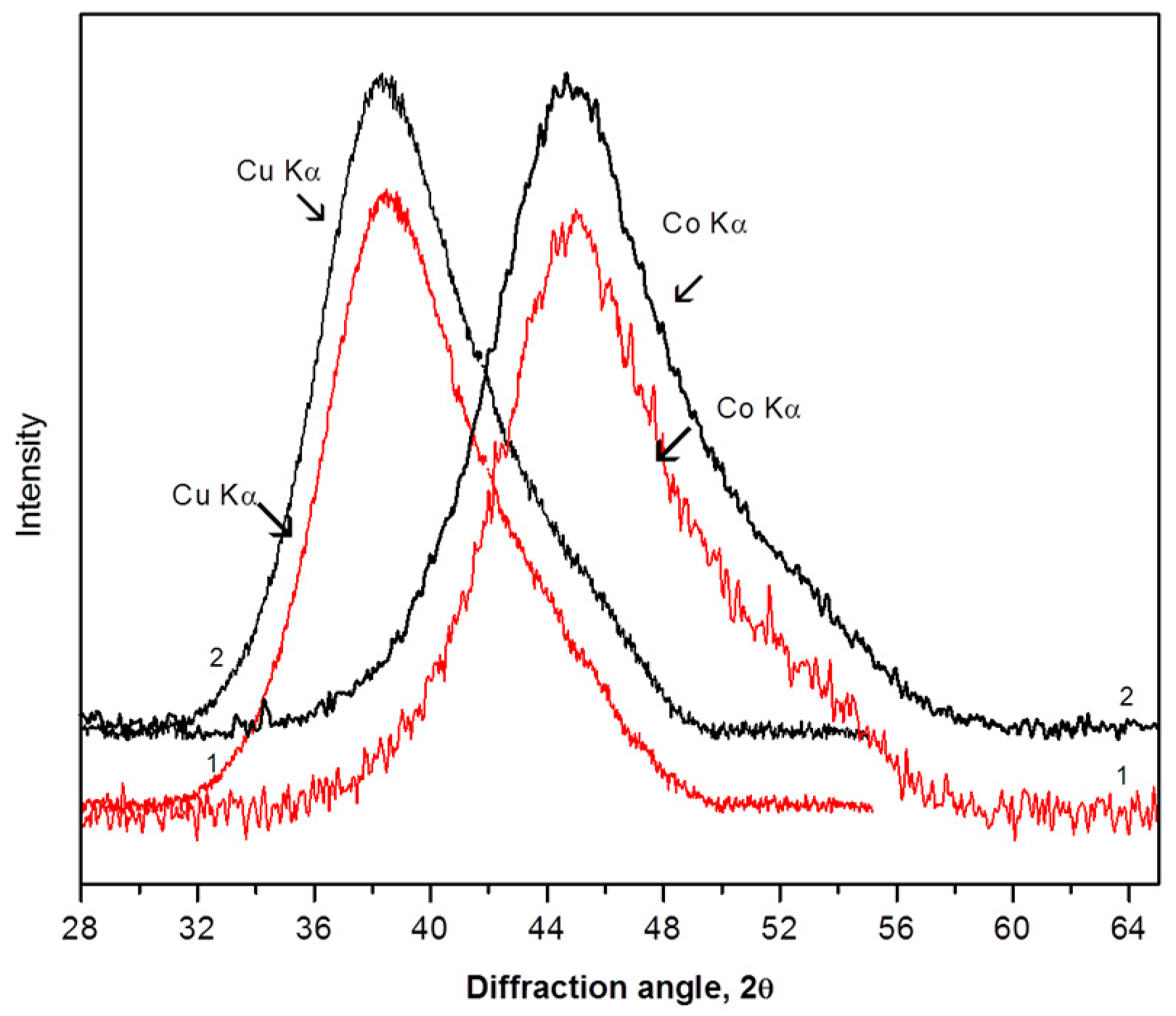
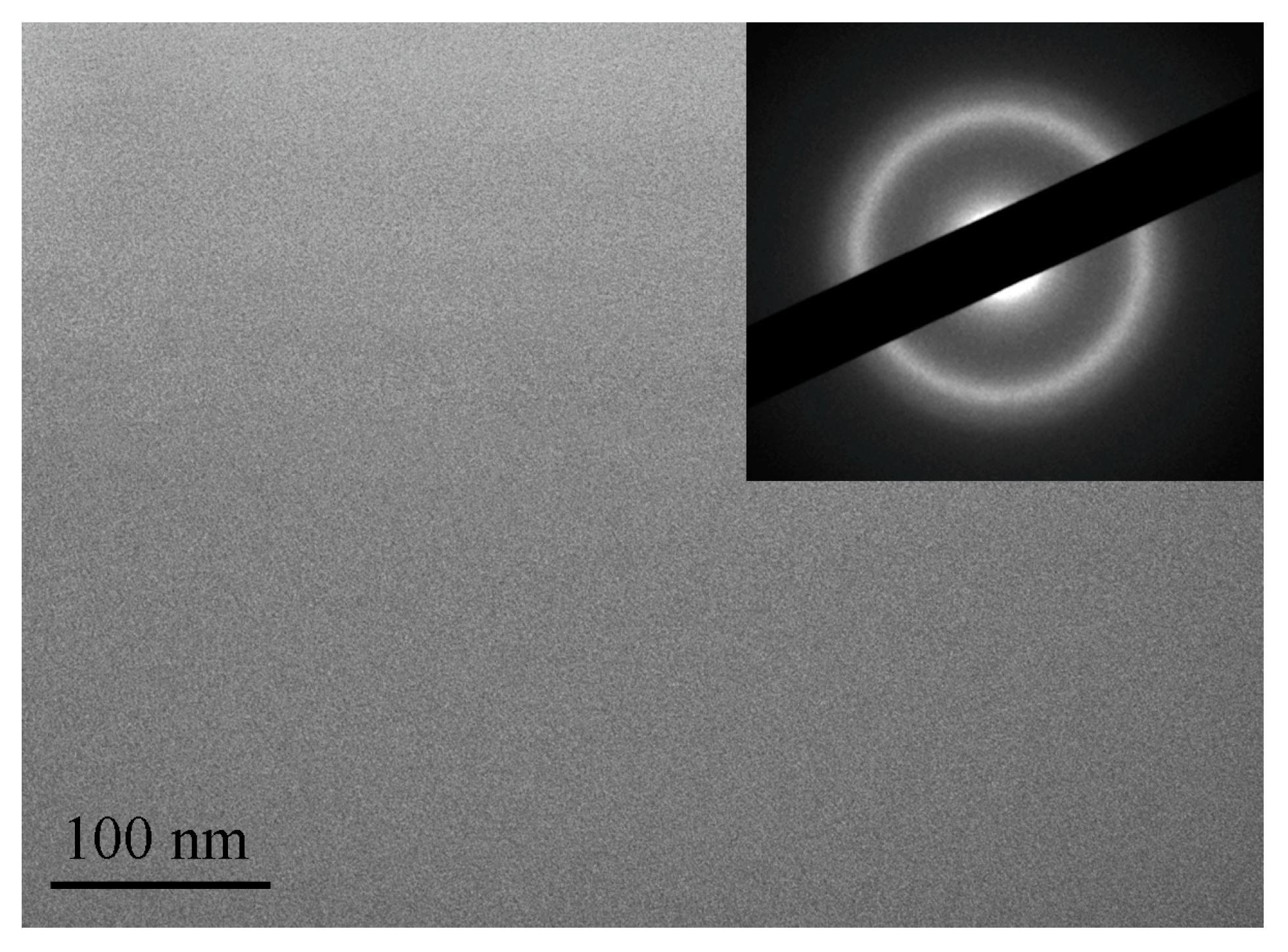
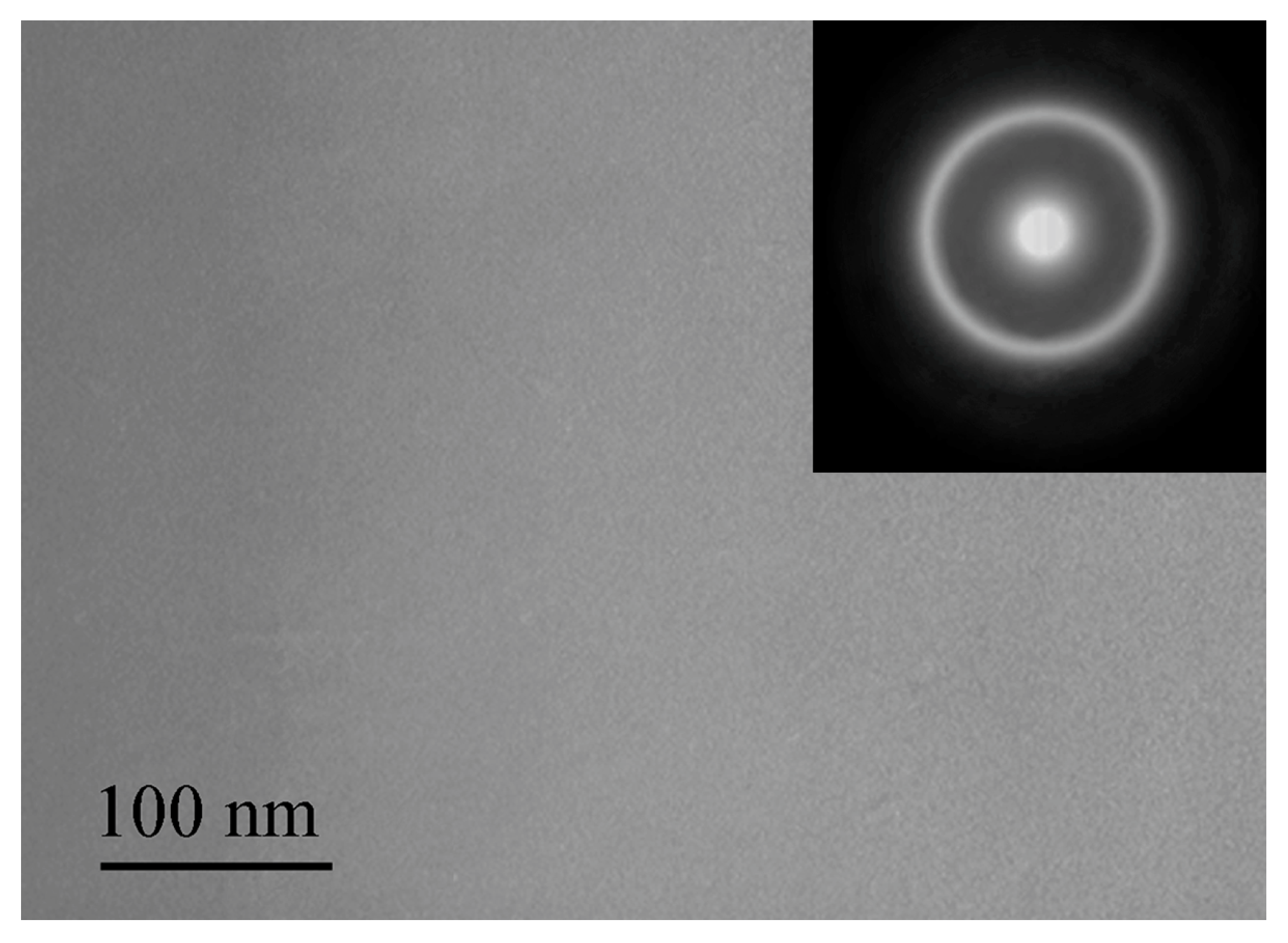
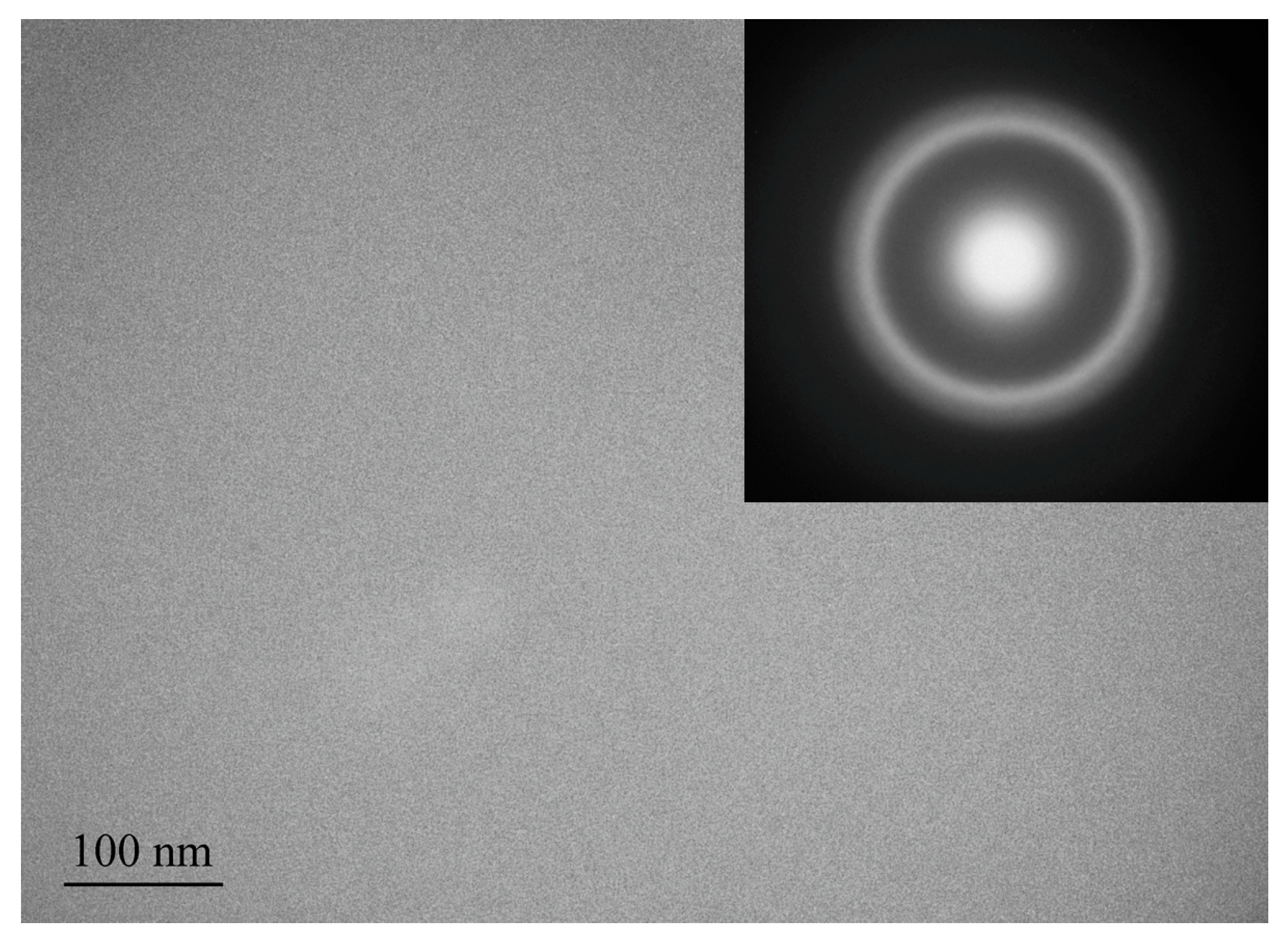

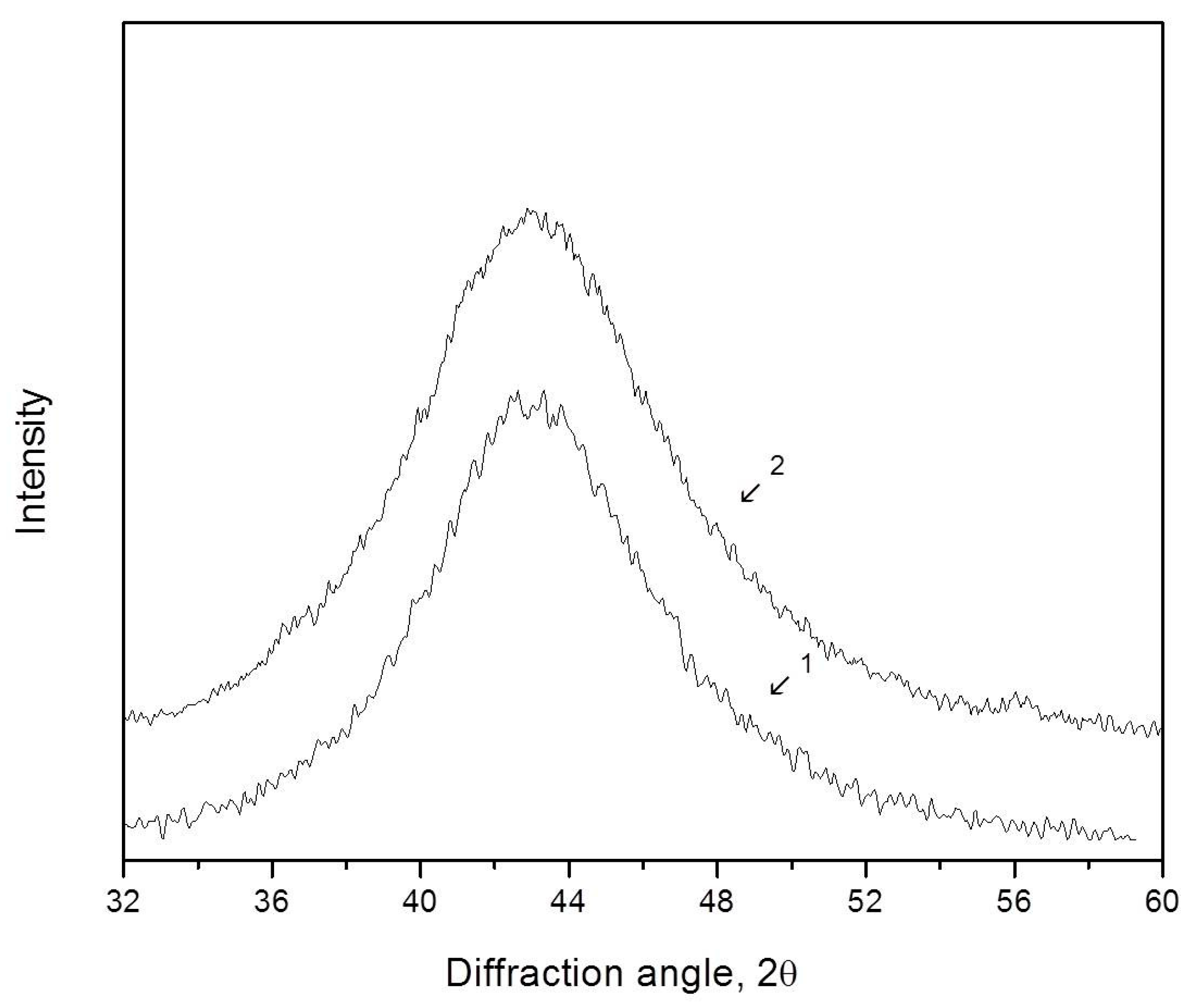
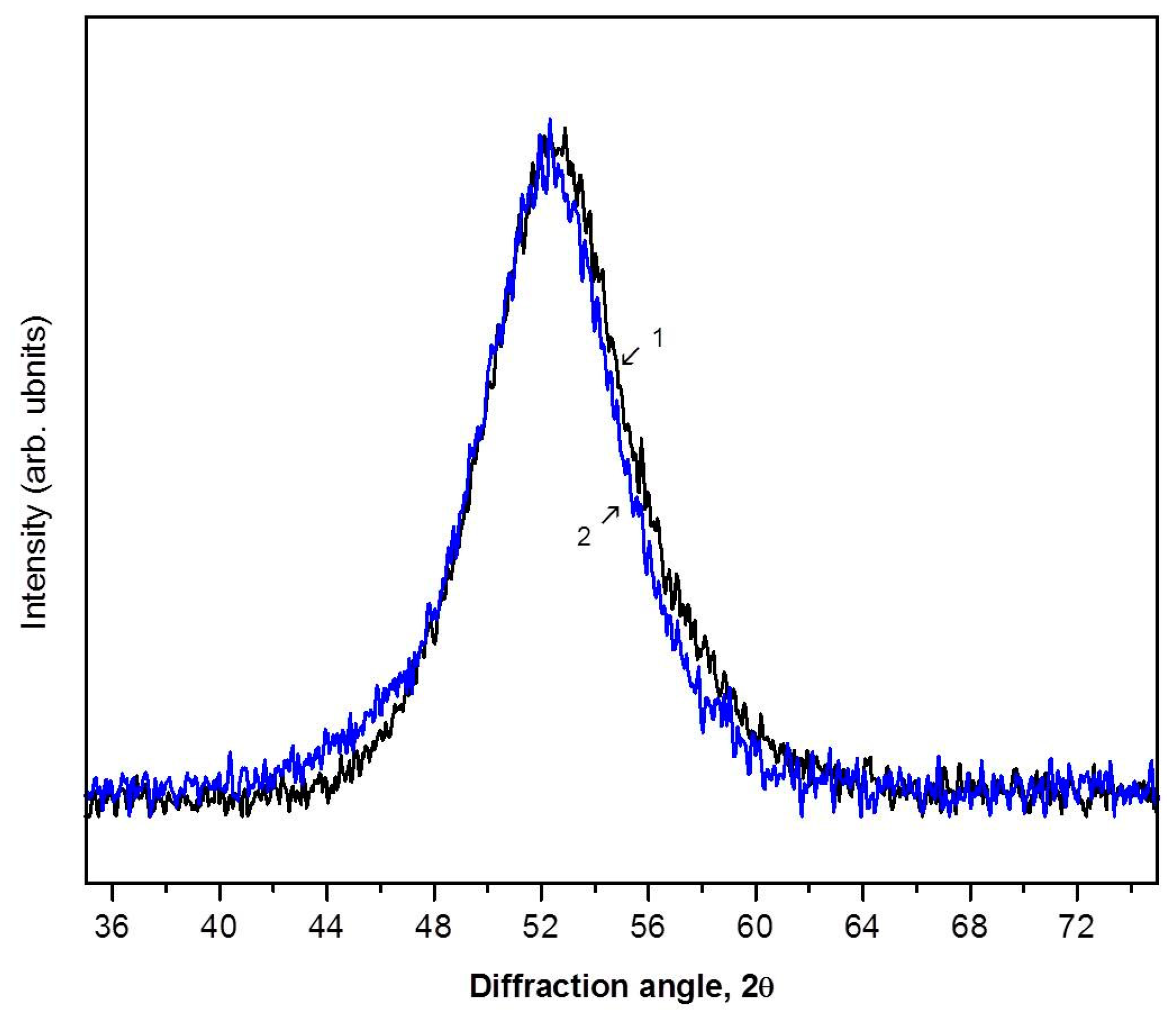
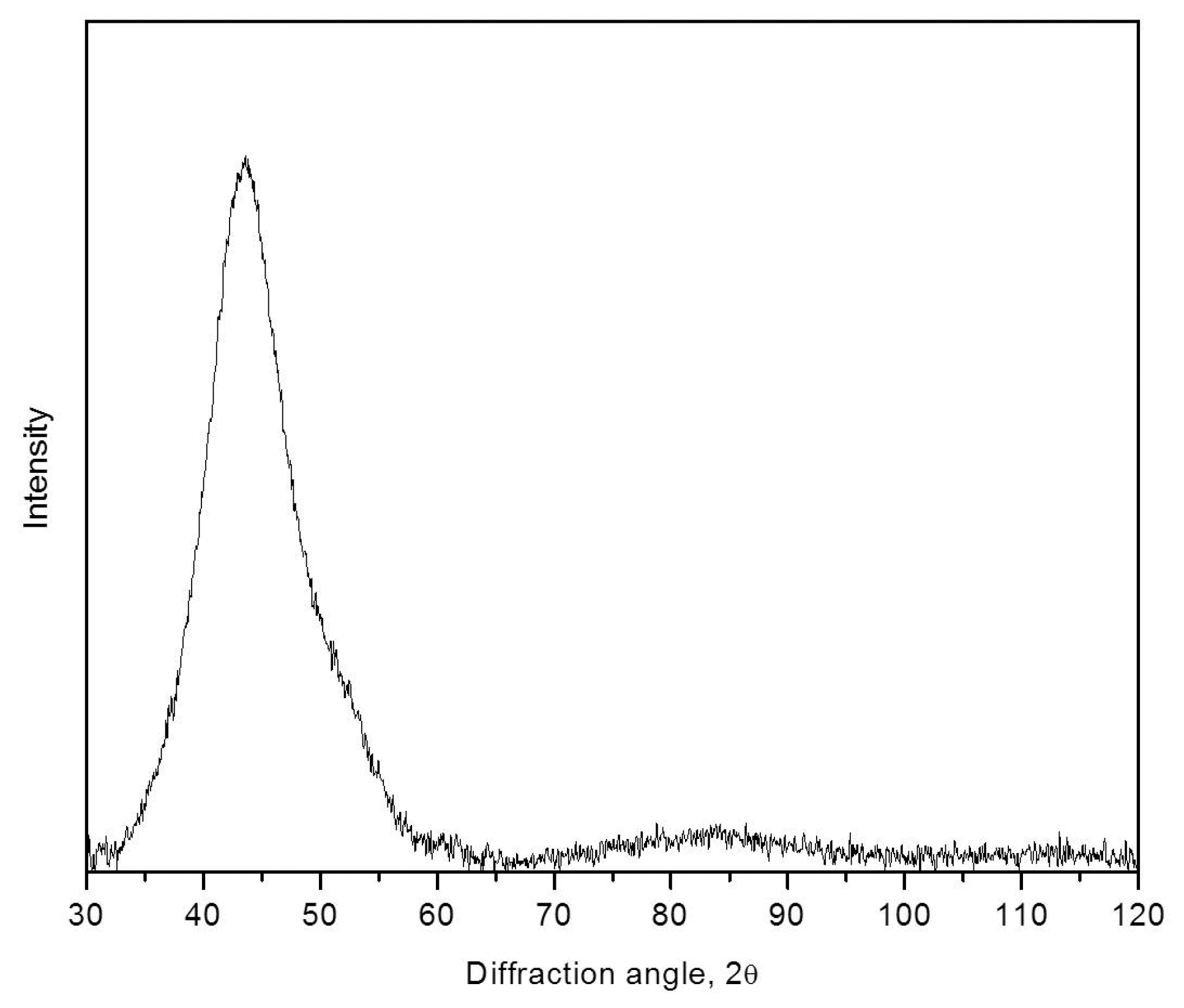
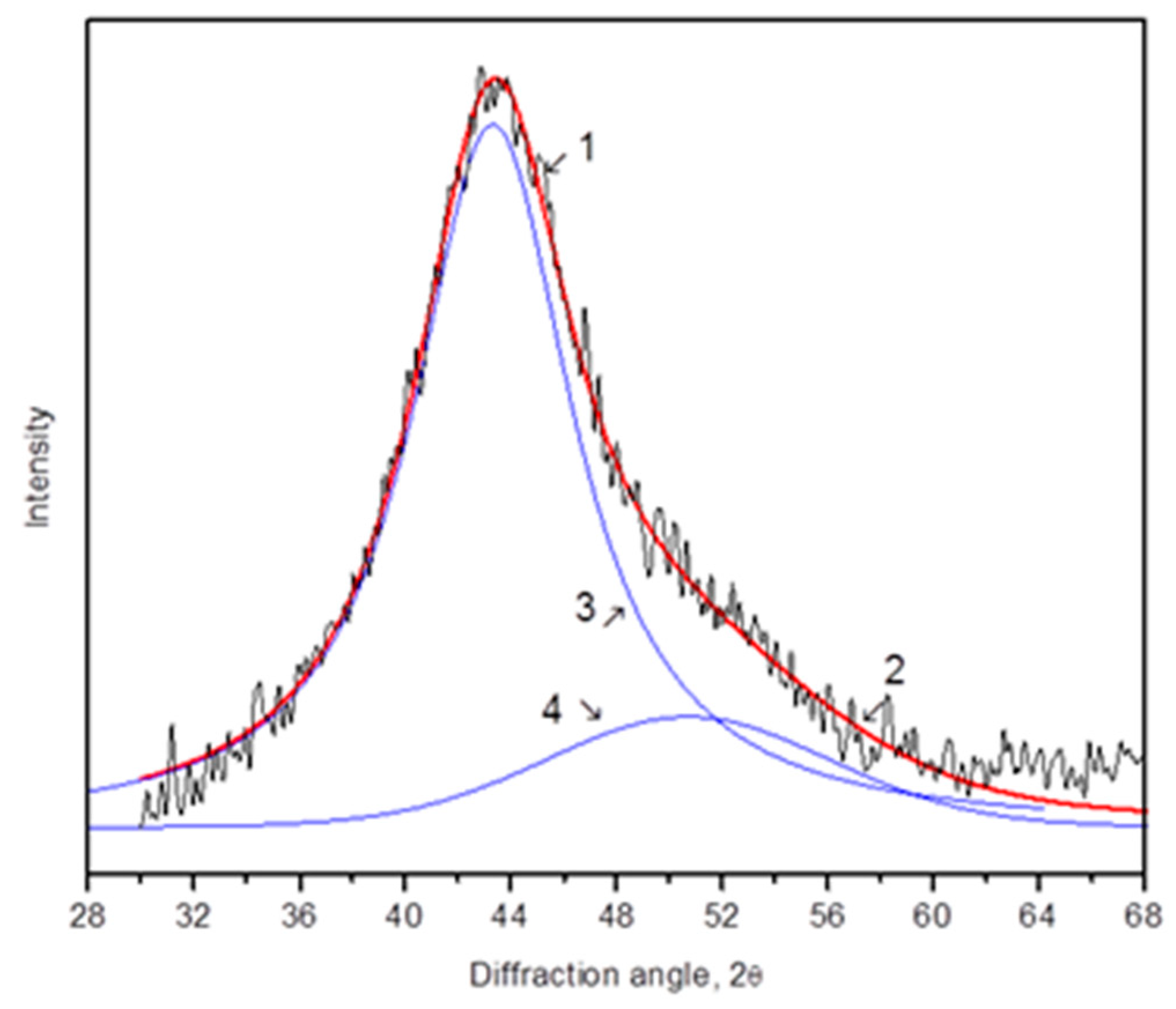


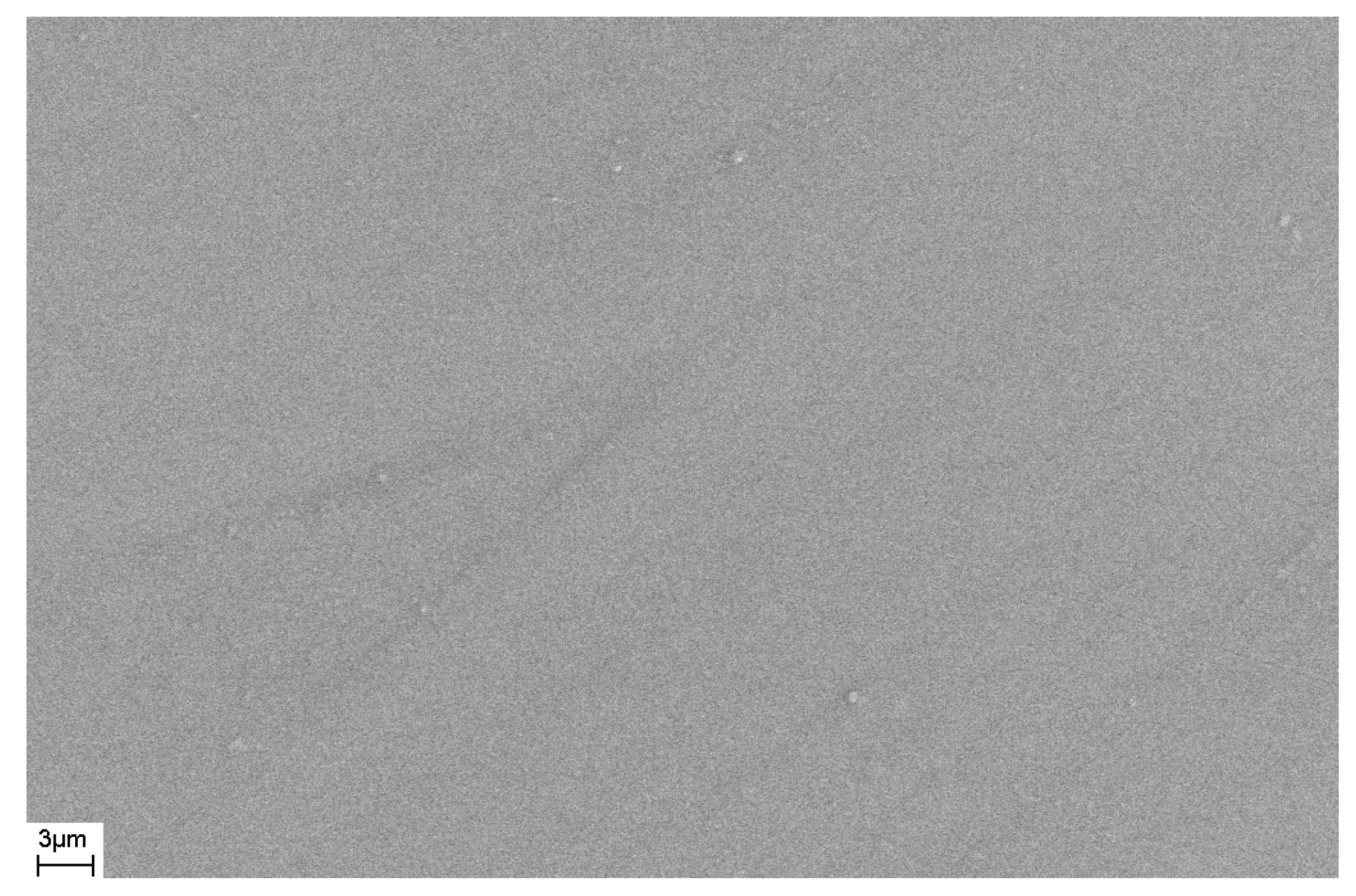
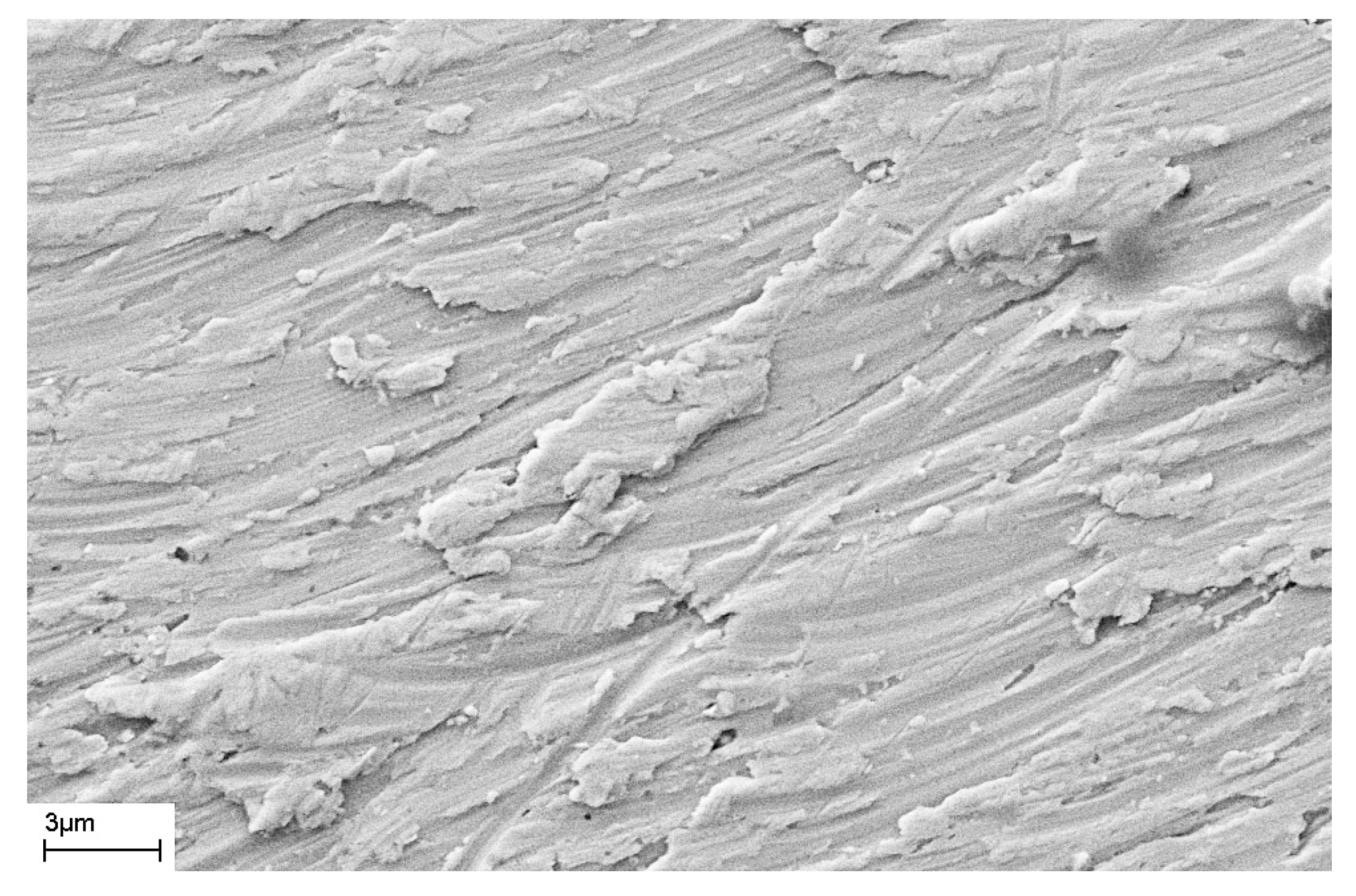
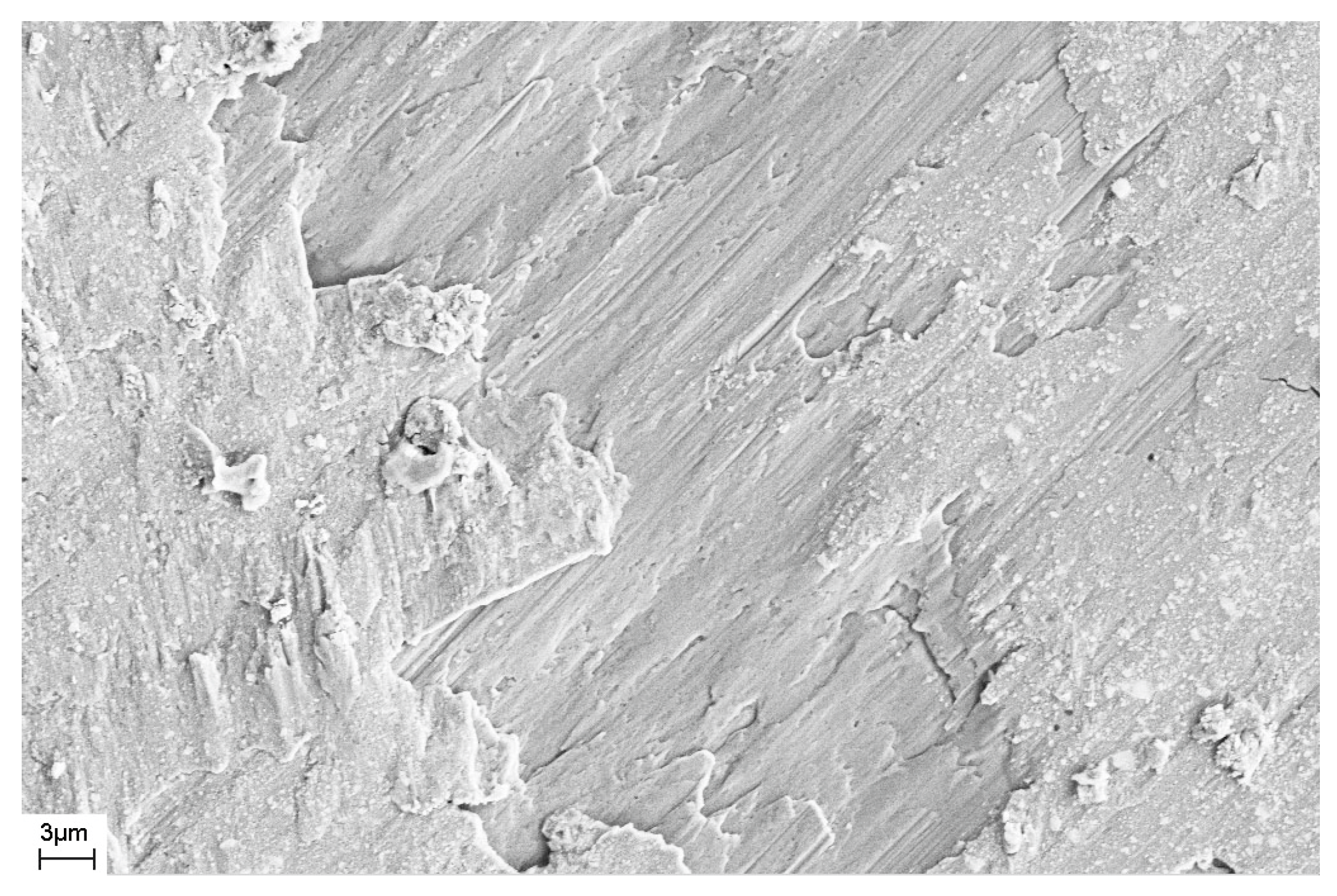
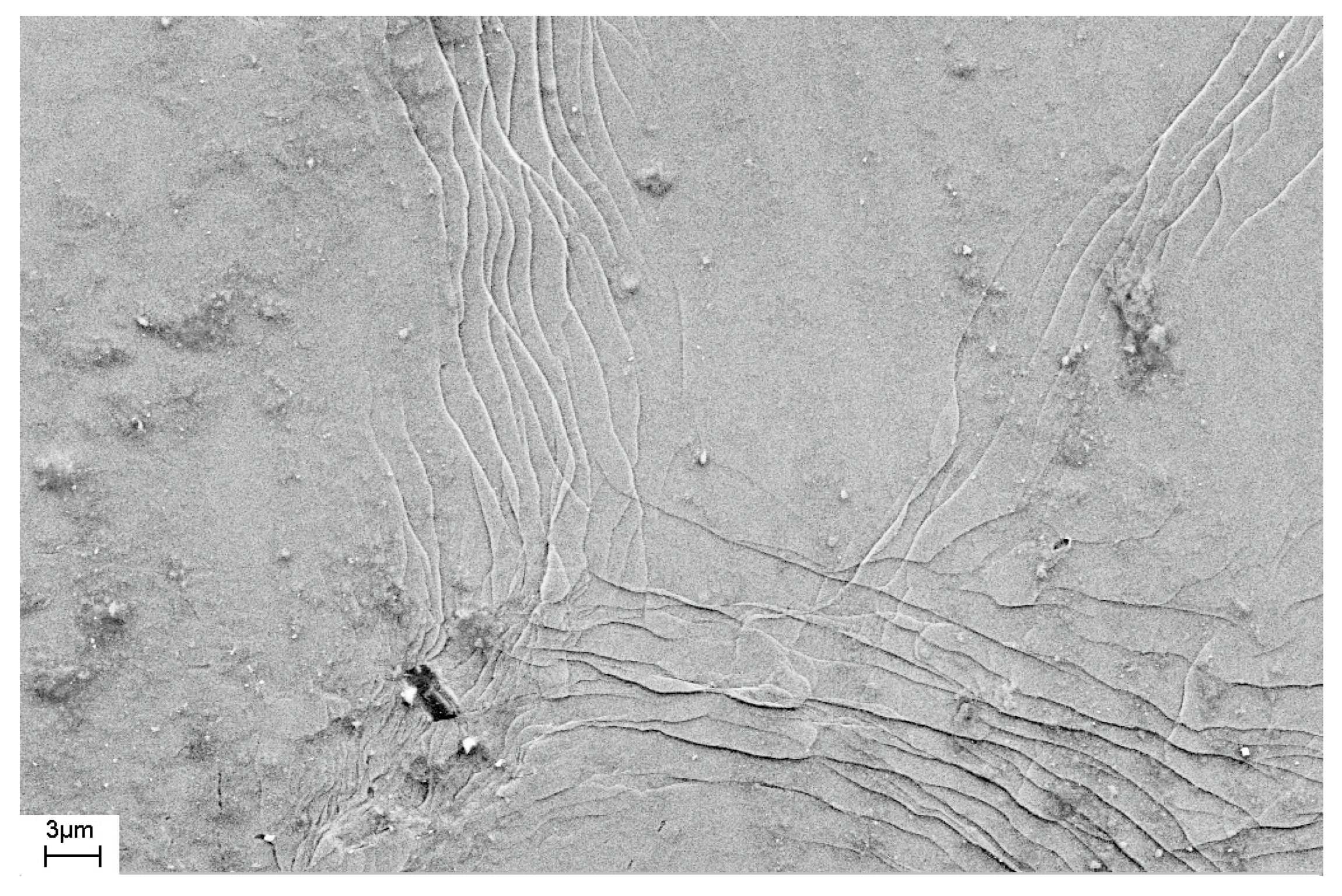

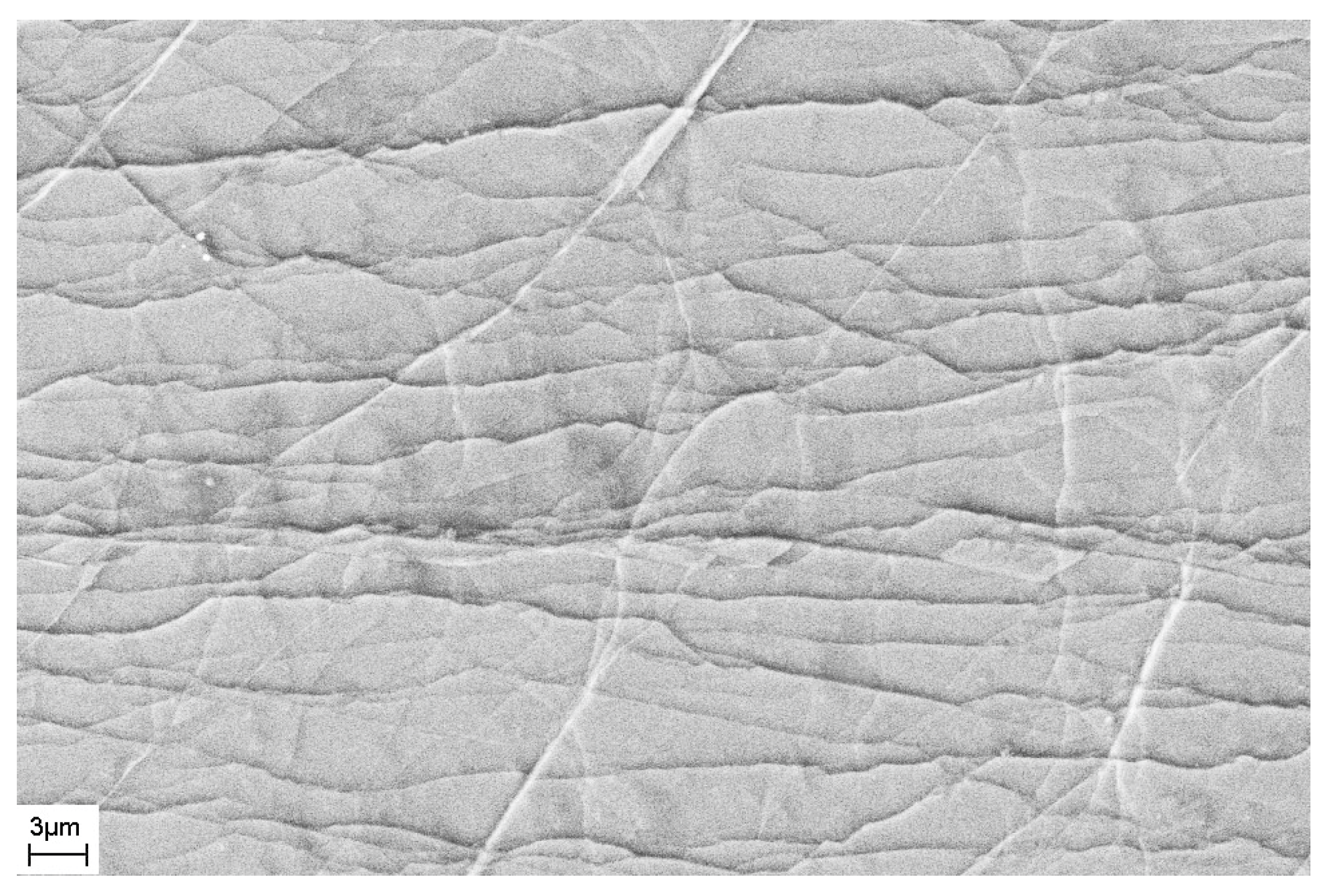
| Chemical Composition, Sample Type | Deformation Conditions | ΔR1, Ǻ | ΔV = (Rdef3 − Rini3)/Rini3 × 100% |
|---|---|---|---|
| Zr62.5Cu22.5Al10Fe5, BMG | HPT 6 GPa, RT, N = 5 | 0.005 | 0.50 |
| Zr62.5Cu22.5Al10Fe5, ribbon | HPT 6 GPa, RT, N = 30 | 0.025 | 2.51 |
| Fe77Si13B10, ribbon | HPT 4 GPa, RT, N = 1 | 0.007 | 0.84 |
| Fe77Si13B10, ribbon | MR, (ho-h)/ho = 5% | 0.001 | 0.12 |
| Al88Ni10Y2, ribbon * | MR, (ho-h)/ho = 50% | 0.010 | 1.05 |
| Al87Ni8Y5, ribbon * | MR, (ho-h)/ho = 35% | 0.023 | [24] |
| Al87Ni8La5, ribbon * | Heat treatment, 150 °C 15 h | 0.550 | [24] |
Disclaimer/Publisher’s Note: The statements, opinions and data contained in all publications are solely those of the individual author(s) and contributor(s) and not of MDPI and/or the editor(s). MDPI and/or the editor(s) disclaim responsibility for any injury to people or property resulting from any ideas, methods, instructions or products referred to in the content. |
© 2023 by the authors. Licensee MDPI, Basel, Switzerland. This article is an open access article distributed under the terms and conditions of the Creative Commons Attribution (CC BY) license (https://creativecommons.org/licenses/by/4.0/).
Share and Cite
Abrosimova, G.; Gunderov, D.; Postnova, E.; Aronin, A. Changes in the Structure of Amorphous Alloys under Deformation by High-Pressure Torsion and Multiple Rolling. Materials 2023, 16, 1321. https://doi.org/10.3390/ma16031321
Abrosimova G, Gunderov D, Postnova E, Aronin A. Changes in the Structure of Amorphous Alloys under Deformation by High-Pressure Torsion and Multiple Rolling. Materials. 2023; 16(3):1321. https://doi.org/10.3390/ma16031321
Chicago/Turabian StyleAbrosimova, Galina, Dmitry Gunderov, Evgenia Postnova, and Alexandr Aronin. 2023. "Changes in the Structure of Amorphous Alloys under Deformation by High-Pressure Torsion and Multiple Rolling" Materials 16, no. 3: 1321. https://doi.org/10.3390/ma16031321
APA StyleAbrosimova, G., Gunderov, D., Postnova, E., & Aronin, A. (2023). Changes in the Structure of Amorphous Alloys under Deformation by High-Pressure Torsion and Multiple Rolling. Materials, 16(3), 1321. https://doi.org/10.3390/ma16031321





